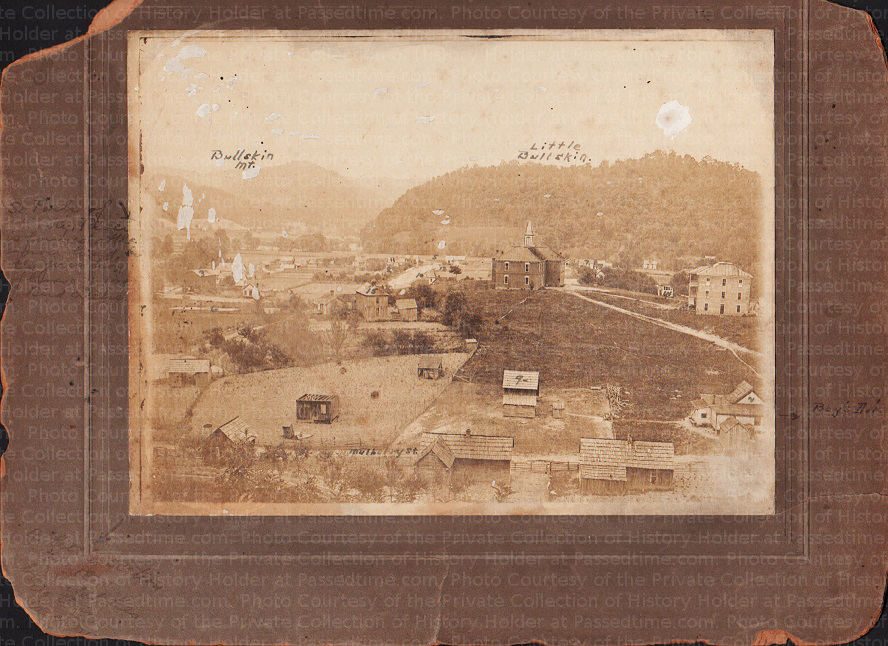"Oh what wonderful memories of Marvin Hall! Those wonderful old hardwood floors, the very wide staircase, the aroma of Miss Ruby Baker's yeast donuts, the movies on Friday afternoon in the auditorium if you had 50 cents--or was it 25?"...Amanda Louise Roberts1
From an artistic standpoint the photograph 2 does not amount to much. It is faded, torn, and has been subject to the ravages of time. However, it may be the only one of its kind for, in a rare demonstration of foresight, some unknown hand labeled the buildings shown in the photograph. Its historical significance should not be questioned, for it provides an early view of the Oneida Baptist Institute.
The Philadelphia Bible Class of the Chestnut Street Baptist Church of Philadelphia, Pennsylvania, visited Bullskin Mountain in August of 1911. Although, the photograph is identified as "Bullskin Mountain", the bible class was visiting the Oneida Baptist Institute. The institute was founded in 1899, at a time when Kentuckians who resided in this area were illiterate, had no access to education, and spent much of their time feuding. Founding member James Anderson Burns (1865-1945), wanted to end the fighting which was destroying many lives, by providing access to Christian education.3
In an inspirational stroke, Burns made the members of the board of trustees the very mountaineers involved in the feuds. The institute began in the Bullskin Mountains with a one-room building and its doors opened on January 1, 1900 with four teachers at the ready. If any of the original 100 students could not afford the $1.00 monthly subscription fee, the family could instead provide payment through services or supplies.4
By 1905, only six years before the date the photograph was taken, the school had dorms for both boys and girls. Additionally, Burns was given a donation from a New York donor, which allowed lands to be purchased for the school. With these funds, Burns installed a school-run farm which was up and running by the time the Chestnut Street Baptist Church visited in 1911.5 After that visit, the institute continued to grow and gain nationwide support which continues even today.
The key listed on the reverse side of the photograph identifies places belonging to individuals such as the home of "P.M. Hugh Combs" or the drug store belonging to "Dr. Jones." The homes of at least three of the professors are identified one belonging to Peters and another to Johnson and Hornschell (this name is conjecture as although the other names are clear, the writing fades out on Hornschell's name). A store is also located as well as Deacon Walker's home and town hotel. The key further identifies impersonal points of interest such as the dormitories, coal shed, and Bre'r Rabbit's barn. Interestingly, there is no location given for a home belonging to the Founder James Anderson Burns. Marvin Hall, of which Ms. Roberts remembers fondly and speaks of so eloquently, is clearly labeled.
1. "Making the Difference" by Amanda Louise Roberts, Alumni Director. OBI Alumni News, January 2014.
2. Photograph courtesy of Private Collection.
3. Webpage: www.oneidaschool.org/history.shtml, unknown author
4. Ibid
5. Ibid

Comments (12)
-
Guest - Reggie Cooper
PermalinkGreat post, good to know that Chestnut Street Baptist Church of Philadelphia visits Oneida Baptist Institute as also share at bestessaystip.com. Glad that it all went food and the end was better than expected.
0 Like -
I recently came across your blog and have been reading along. I thought I would leave my first comment. I don’t know what to say except https://www.emergencyessays.com/ that I have enjoyed reading. Nice blog. I will keep visiting this blog very often.I’ll use this information for my essays.
0 Like -
Guest - annu
PermalinkI have heard a lot about this Baptist church. But I got only minimal information about it. I would like to know more about this church. Hope you will provide more details about it as soon as possible. Eagerly waiting for your updated post to know more. Wholesale Tablet
0 Like -
paytmrechargeoffer.com/ Due to the current campaign in India to make all transactions cashless
0 Like -
YIFY movie is the most popular torrent movie download website available for all the users around the world.
0 Like -
Do you ever think of about the credit card which you get many offers to your profile www.capitolone.com
0 Like -
It is a cutting-edge camera build on advanced technology that operates silently sony a7 iii
0 Like

Leave your comments
Login to post a comment
Post comment as a guest